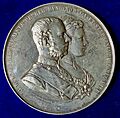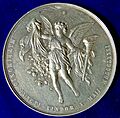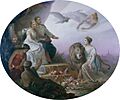Rudolf, Crown Prince of Austria facts for kids
Quick facts for kids Rudolf |
|||||
|---|---|---|---|---|---|
| Crown Prince of Austria Prince Royal of Hungary and Bohemia |
|||||

Rudolf in 1887
|
|||||
| Born | 21 August 1858 Schloss Laxenburg, Laxenburg, Lower Austria, Austrian Empire |
||||
| Died | 30 January 1889 (aged 30) Mayerling, Lower Austria, Austria-Hungary |
||||
| Burial | Imperial Crypt, Vienna | ||||
| Spouse | |||||
| Issue | Elisabeth Marie, Princess Otto of Windisch-Graetz | ||||
|
|||||
| House | Habsburg-Lorraine | ||||
| Father | Franz Joseph I of Austria | ||||
| Mother | Elisabeth in Bavaria | ||||
| Religion | Roman Catholicism | ||||
| Signature |  |
||||
Rudolf, Crown Prince of Austria (born Rudolf Franz Karl Josef; August 21, 1858 – January 30, 1889) was the only son of Emperor Franz Joseph I of Austria. His mother was Empress Elisabeth. From the moment he was born, Rudolf was the heir apparent, meaning he was next in line to the throne of the Austro-Hungarian Empire.
Contents
Early Life and Education
Rudolf was born at Schloss Laxenburg, a beautiful castle near Vienna. He was named after Rudolf I, who was the first Habsburg King of Germany. King Rudolf I ruled from 1273 to 1291.
Rudolf grew up with his older sister, Gisela. They were very close friends. When Rudolf was six years old, he began his special education. This training was to prepare him to become the future Emperor of Austria. Even though they were separated for his studies, Rudolf and Gisela remained close. Their bond lasted until Gisela moved away after marrying Prince Leopold of Bavaria.
Rudolf had a tutor named Ferdinand von Hochstetter. This tutor helped Rudolf become very interested in natural sciences. From a young age, Rudolf started collecting minerals. After his death, many of his minerals were given to the University of Agriculture in Vienna. Today, this university is known as the University of Natural Resources and Life Sciences, Vienna.
Rudolf had different ideas than his father, Emperor Franz Joseph I. Rudolf believed in liberal ideas, which were more like his mother's views. However, his relationship with his mother was sometimes difficult.
Marriage and Family
On May 10, 1881, Rudolf married Princess Stéphanie of Belgium in Vienna. Stéphanie was the daughter of King Leopold II of Belgium. Their wedding took place at the Augustinian Church.
At first, their marriage was happy. But by the time their only child was born, things had changed. Their daughter, Archduchess Elisabeth, was born on September 2, 1883. After her birth, Rudolf and Stéphanie grew apart.
In 1886, Rudolf became very ill. He and Stéphanie traveled to the island of Lacroma (now in Croatia) for his treatment. During their journey, Stéphanie also became very ill. The Emperor ordered that their illness be kept a secret. By 1889, people at the royal court knew that Stéphanie could not have more children. They also knew that Rudolf's health was getting worse.
Impact of Rudolf's Death
Rudolf's death caused his mother, Empress Elisabeth, great sadness. She wore black or grey clothes for the rest of her life. She also spent more and more time away from the royal court in Vienna. In 1898, while Elisabeth was in Geneva, Switzerland, she was murdered by an Italian anarchist named Luigi Lucheni.
Rudolf's death meant that Emperor Franz Joseph I no longer had a direct male heir. His younger brother, Archduke Karl Ludwig, was next in line. However, Karl Ludwig died in 1896. This made Karl Ludwig's oldest son, Archduke Franz Ferdinand, the new heir.
In 1914, Archduke Franz Ferdinand was assassinated. This event helped start World War I. When Emperor Franz Joseph I died in 1916, his grandnephew, Charles I of Austria, became the new Emperor.
In 1918, the Austro-Hungarian Empire ended. This happened partly because of demands from American President Woodrow Wilson. Emperor Charles I and his family went to live in Switzerland.
Titles and Honours
Titles and Styles
- August 21, 1858 – January 30, 1889: His Imperial and Royal Highness The Crown Prince of Austria, Hungary, Bohemia and Croatia
Honours
- From Austria-Hungary
- Knight of the Golden Fleece, 1858
- Grand Cross of the Royal Hungarian Order of St. Stephen, 1877
- From Other Countries
 Baden:
Baden:
- Knight of the House Order of Fidelity, 1873
- Grand Cross of the Zähringer Lion, 1873
 Bavaria: Knight of St. Hubert, in Diamonds, 1868
Bavaria: Knight of St. Hubert, in Diamonds, 1868 Belgium: Grand Cordon of the Order of Leopold, 1880
Belgium: Grand Cordon of the Order of Leopold, 1880 Brazil: Grand Cross of the Southern Cross
Brazil: Grand Cross of the Southern Cross Denmark: Knight of the Elephant, November 24, 1873
Denmark: Knight of the Elephant, November 24, 1873

 Ernestine duchies: Grand Cross of the Saxe-Ernestine House Order
Ernestine duchies: Grand Cross of the Saxe-Ernestine House Order France: Grand Cross of the Legion of Honour
France: Grand Cross of the Legion of Honour Greece: Grand Cross of the Redeemer
Greece: Grand Cross of the Redeemer Hesse and by Rhine: Grand Cross of the Ludwig Order, August 21, 1865
Hesse and by Rhine: Grand Cross of the Ludwig Order, August 21, 1865 Italy: Knight of the Annunciation, May 6, 1881
Italy: Knight of the Annunciation, May 6, 1881
 Parmese Ducal Family: Grand Cross of the Constantinian Order of St. George
Parmese Ducal Family: Grand Cross of the Constantinian Order of St. George Tuscan Grand Ducal Family: Grand Cross of St. Joseph
Tuscan Grand Ducal Family: Grand Cross of St. Joseph
 Sovereign Military Order of Malta: Bailiff Grand Cross of Honour and Devotion
Sovereign Military Order of Malta: Bailiff Grand Cross of Honour and Devotion Japan: Grand Cordon of the Order of the Chrysanthemum, February 14, 1881
Japan: Grand Cordon of the Order of the Chrysanthemum, February 14, 1881 Mecklenburg: Grand Cross of the Wendish Crown, with Crown in Ore
Mecklenburg: Grand Cross of the Wendish Crown, with Crown in Ore Mexican Empire: Grand Cross of the Mexican Eagle, 1865
Mexican Empire: Grand Cross of the Mexican Eagle, 1865 Montenegro: Grand Cross of the Order of Prince Danilo I
Montenegro: Grand Cross of the Order of Prince Danilo I Nassau Ducal Family: Knight of the Gold Lion of Nassau
Nassau Ducal Family: Knight of the Gold Lion of Nassau Netherlands: Grand Cross of the Netherlands Lion
Netherlands: Grand Cross of the Netherlands Lion Ottoman Empire: Order of Osmanieh, 1st Class
Ottoman Empire: Order of Osmanieh, 1st Class Tunisia: Husainid Family Order, in Diamonds
Tunisia: Husainid Family Order, in Diamonds Persia: Order of the August Portrait, in Diamonds, August 1, 1873
Persia: Order of the August Portrait, in Diamonds, August 1, 1873 Portugal: Grand Cross of the Sash of the Two Orders
Portugal: Grand Cross of the Sash of the Two Orders Prussia:
Prussia:
- Knight of the Black Eagle, August 21, 1864
- Grand Commander's Cross of the Royal House Order of Hohenzollern
 Russia:
Russia:
- Knight of St. Andrew, 1878
- Knight of St. Alexander Nevsky
- Knight of the White Eagle
- Knight of St. Anna, 1st Class
- Knight of St. Stanislaus, 1st Class
 Romania: Grand Cross of the Star of Romania
Romania: Grand Cross of the Star of Romania San Marino: Grand Cross of the Order of San Marino
San Marino: Grand Cross of the Order of San Marino Serbia: Grand Cross of the Cross of Takovo
Serbia: Grand Cross of the Cross of Takovo Saxe-Weimar-Eisenach: Grand Cross of the White Falcon, 1873
Saxe-Weimar-Eisenach: Grand Cross of the White Falcon, 1873 Saxony: Knight of the Rue Crown, 1876
Saxony: Knight of the Rue Crown, 1876 Siam:
Siam:
- Grand Cross of the White Elephant
- Grand Cross of the Crown of Siam
 Spain: Grand Cross of the Order of Charles III, June 5, 1875
Spain: Grand Cross of the Order of Charles III, June 5, 1875
 Sweden-Norway: Knight of the Seraphim, April 15, 1879
Sweden-Norway: Knight of the Seraphim, April 15, 1879 United Kingdom:
United Kingdom:
- Stranger Knight Companion of the Garter, June 20, 1887
- Gold Medal Commemorating the Golden Jubilee of Queen Victoria
 Württemberg: Grand Cross of the Württemberg Crown, 1873
Württemberg: Grand Cross of the Württemberg Crown, 1873
Images for kids
-
The coat of arms of Rudolf, Crown Prince of Austria, showing the Order of the Garter.
See also
 In Spanish: Rodolfo de Habsburgo (príncipe heredero de Austria) para niños
In Spanish: Rodolfo de Habsburgo (príncipe heredero de Austria) para niños
- Lake Rudolf
- Alma V. Hayne
- Rudolf Island
- List of heirs to the Austrian throne













